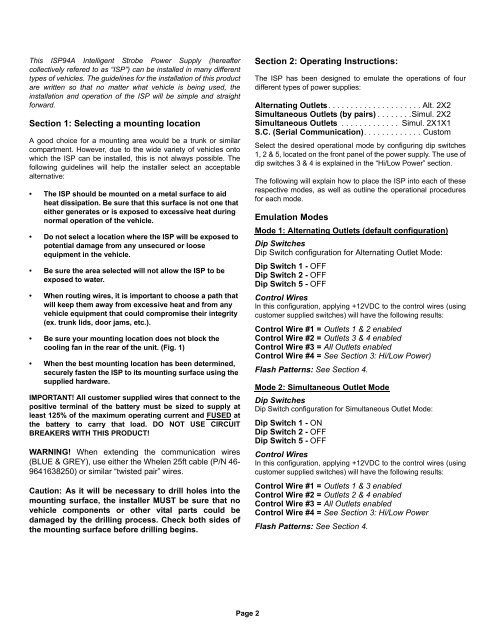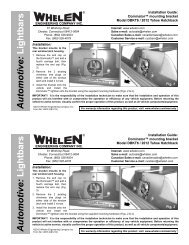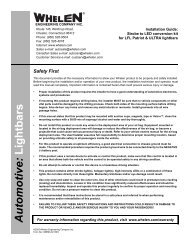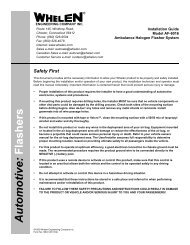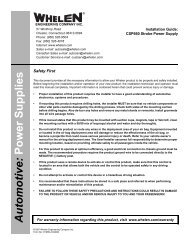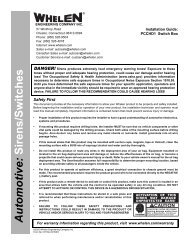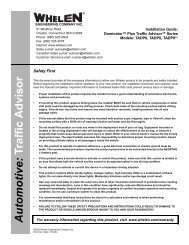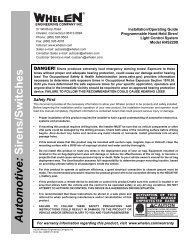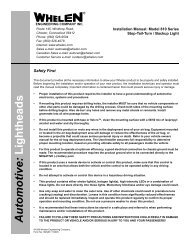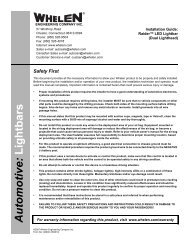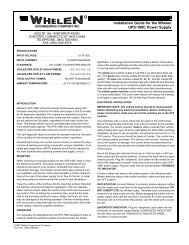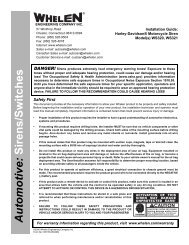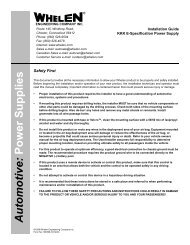13205: ISP94A Intelligent Strobe Power Supply - Whelen Engineering
13205: ISP94A Intelligent Strobe Power Supply - Whelen Engineering
13205: ISP94A Intelligent Strobe Power Supply - Whelen Engineering
You also want an ePaper? Increase the reach of your titles
YUMPU automatically turns print PDFs into web optimized ePapers that Google loves.
This <strong>ISP94A</strong> <strong>Intelligent</strong> <strong>Strobe</strong> <strong>Power</strong> <strong>Supply</strong> (hereafter<br />
collectively refered to as “ISP”) can be installed in many different<br />
types of vehicles. The guidelines for the installation of this product<br />
are written so that no matter what vehicle is being used, the<br />
installation and operation of the ISP will be simple and straight<br />
forward.<br />
Section 1: Selecting a mounting location<br />
A good choice for a mounting area would be a trunk or similar<br />
compartment. However, due to the wide variety of vehicles onto<br />
which the ISP can be installed, this is not always possible. The<br />
following guidelines will help the installer select an acceptable<br />
alternative:<br />
• The ISP should be mounted on a metal surface to aid<br />
heat dissipation. Be sure that this surface is not one that<br />
either generates or is exposed to excessive heat during<br />
normal operation of the vehicle.<br />
• Do not select a location where the ISP will be exposed to<br />
potential damage from any unsecured or loose<br />
equipment in the vehicle.<br />
• Be sure the area selected will not allow the ISP to be<br />
exposed to water.<br />
• When routing wires, it is important to choose a path that<br />
will keep them away from excessive heat and from any<br />
vehicle equipment that could compromise their integrity<br />
(ex. trunk lids, door jams, etc.).<br />
• Be sure your mounting location does not block the<br />
cooling fan in the rear of the unit. (Fig. 1)<br />
• When the best mounting location has been determined,<br />
securely fasten the ISP to its mounting surface using the<br />
supplied hardware.<br />
IMPORTANT! All customer supplied wires that connect to the<br />
positive terminal of the battery must be sized to supply at<br />
least 125% of the maximum operating current and FUSED at<br />
the battery to carry that load. DO NOT USE CIRCUIT<br />
BREAKERS WITH THIS PRODUCT!<br />
WARNING! When extending the communication wires<br />
(BLUE & GREY), use either the <strong>Whelen</strong> 25ft cable (P/N 46-<br />
9641638250) or similar “twisted pair” wires.<br />
Caution: As it will be necessary to drill holes into the<br />
mounting surface, the installer MUST be sure that no<br />
vehicle components or other vital parts could be<br />
damaged by the drilling process. Check both sides of<br />
the mounting surface before drilling begins.<br />
Section 2: Operating Instructions:<br />
The ISP has been designed to emulate the operations of four<br />
different types of power supplies:<br />
Alternating Outlets. . . . . . . . . . . . . . . . . . . . . Alt. 2X2<br />
Simultaneous Outlets (by pairs) . . . . . . . .Simul. 2X2<br />
Simultaneous Outlets . . . . . . . . . . . . . Simul. 2X1X1<br />
S.C. (Serial Communication). . . . . . . . . . . . . Custom<br />
Select the desired operational mode by configuring dip switches<br />
1, 2 & 5, located on the front panel of the power supply. The use of<br />
dip switches 3 & 4 is explained in the “Hi/Low <strong>Power</strong>” section.<br />
The following will explain how to place the ISP into each of these<br />
respective modes, as well as outline the operational procedures<br />
for each mode.<br />
Emulation Modes<br />
Mode 1: Alternating Outlets (default configuration)<br />
Dip Switches<br />
Dip Switch configuration for Alternating Outlet Mode:<br />
Dip Switch 1 - OFF<br />
Dip Switch 2 - OFF<br />
Dip Switch 5 - OFF<br />
Control Wires<br />
In this configuration, applying +12VDC to the control wires (using<br />
customer supplied switches) will have the following results:<br />
Control Wire #1 = Outlets 1 & 2 enabled<br />
Control Wire #2 = Outlets 3 & 4 enabled<br />
Control Wire #3 = All Outlets enabled<br />
Control Wire #4 = See Section 3: Hi/Low <strong>Power</strong>)<br />
Flash Patterns: See Section 4.<br />
Mode 2: Simultaneous Outlet Mode<br />
Dip Switches<br />
Dip Switch configuration for Simultaneous Outlet Mode:<br />
Dip Switch 1 - ON<br />
Dip Switch 2 - OFF<br />
Dip Switch 5 - OFF<br />
Control Wires<br />
In this configuration, applying +12VDC to the control wires (using<br />
customer supplied switches) will have the following results:<br />
Control Wire #1 = Outlets 1 & 3 enabled<br />
Control Wire #2 = Outlets 2 & 4 enabled<br />
Control Wire #3 = All Outlets enabled<br />
Control Wire #4 = See Section 3: Hi/Low <strong>Power</strong><br />
Flash Patterns: See Section 4.<br />
Page 2


